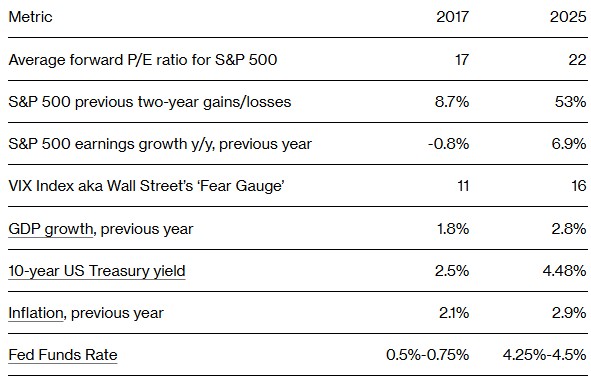
Trump's second term sees a resurgence of "whimsicality," and U.S. stock investors urgently need a new action guide

美國總統特朗普對關税的反覆無常態度導致市場劇烈震盪,投資者面臨新挑戰。與其第一個任期相比,當前市場波動性更高,標準普爾 500 指數在 2023 年和 2024 年累計上漲 53%。分析師建議採取防禦性投資策略,警惕可能的貿易戰和宏觀環境變化。儘管經濟仍在增長,但美股前景令人擔憂,任何脆弱性都可能擾亂市場。
智通財經 APP 獲悉,上週,美國總統唐納德•特朗普對其標誌性關税的反覆無常態度令市場劇烈震盪。試圖調整股票投資組合以應對這種持續不確定性的投資者發現,參照這位前總統在其第一個任期的打法幫助並不大。
特朗普的策略仍然未變,即承諾對貿易伙伴徵收積極的關税,然後迅速收回,要麼推遲徵收,要麼完全取消徵收。除此之外,基本上其他一切都在變化。
首先,他提出的關税影響商品範圍將比他第一個任期更廣泛。但更重要的是,投資者正處於一個完全不同的波動性更高的範式中。標準普爾 500 指數正處於火熱的上漲勢頭,在 2023 年和 2024 年累計上漲 53%,將估值推向了牛市高位。相比之下,2017 年標準普爾 500 指數在之前兩年裏的總漲幅僅為 8.7%,這給了特朗普上任後股價上漲的更大空間。
對 Ned Davis Research 首席全球投資策略師海耶斯 (Tim Hayes) 來説,這意味着在配置風險資產時採取一種防禦性的方式。他表示,“如果關税引發貿易戰,導致債券收益率上升,宏觀環境惡化,以及科技行業和美國市場的大規模外流”,該公司的投資模式可能會考慮削減股票配置。
這種謹慎強調了宏觀環境也發生了變化。通脹正在加劇,利率要高得多。與八年前相比,聯邦赤字是一個更令人頭疼的問題。綜上所述,儘管經濟仍在蓬勃發展,美股背景卻令人擔憂得多。
Strategas Securities LLC 的 ETF 和技術策略師託德•索恩 (Todd Sohn) 表示:“我們正處於牛市進入第三年的高預期環境中,而 2017 年我們剛剛走出熊市。當出現任何形式的脆弱性時,任何催化劑都可能擾亂市場。”
較高的敞口
摩根大通全球股票策略主管 Mislav Matejka 彙編的數據顯示,資管公司對股票期貨的敞口目前高於 40%。2017 年,這一比例低於 10%。這意味着,與特朗普首次上任時相比,投資者在未來幾個月購買股票的 “幹火藥” 要少得多。

從一個指標來看,投資者對股市的預期在總統任期伊始從未如此之高。Creative Planning 首席市場策略師查理•比列羅 (Charlie Bilello) 表示,1 月底,經週期調整後的市盈率 (CAPE) 接近 38,是一個 “極高” 的水平。
“從歷史上看,這意味着未來 10 年股市的回報率低於平均水平,” 他補充道。
頭寸情況也十分類似。美國股票風險溢價 (ERP) 作為衡量股票和債券預期回報之差的指標正深陷負值區域,這是自本世紀初以來從未發生過的。這是否是股價的負面指標取決於經濟週期。較低的數字可以被視為表明企業利潤將會上升,也可能意味着股價上漲過快,遠高於實際價值。

然而,到目前為止,第四季度財報季顯示出一種令人不安的趨勢。超過盈利預期的美國公司越來越少,關税談判主導着財報電話會議,2025 年的前景已經開始受到衝擊。
因投資者擔心關税因素將對今年汽車行業收益造成影響,福特汽車 (F.US) 和通用汽車 (GM.US) 公佈財報後股價大跌。工業巨頭卡特彼勒 (CAT.US) 被認為是交易緊張局勢的代表,該公司警告稱,在需求壓力下,收入將下降,而其銷售的高價設備價格上漲只會使這種情況變得更糟。
減少泡沫
與此同時,一些投資者正在關注股市中的小眾市場,這些市場的估值泡沫較小,歷史模式更有利。證券投資公司 Certuity 的首席投資官斯科特•韋爾奇 (Scott Welch) 正將資金重新配置到一個通常在美聯儲降息時表現搶眼、卻被市場遺忘的領域:中盤股。
韋爾奇在接受採訪時表示:“大市值科技巨頭的定價是完美的,因此不會造成太大的破壞。”“他們已經在上漲,因為他們有強勁的盈利和現金流,但沒有什麼是永恆的。”
大規模的宏觀風險,如特朗普的關税,往往會導致股市像一塊巨石一樣移動。事實上,股價在 2018 年底變得高度相關,當時中美貿易緊張局勢醖釀,美聯儲利率政策的路徑對股市產生了廣泛影響。芝加哥期權交易所 (CBOE) 的 3 個月隱含相關性指數當時飆升,標準普爾 500 指數創下全球金融危機以來的最大年度跌幅。

目前,這一相關指數徘徊在歷史低點附近,這意味着股市走勢並不一致。這對市場來説通常是一個健康的信號,表明公司特定的基本面對宏觀經濟發展的影響更大。然而,不利的一面是,它使得投資者承擔更多風險。
最終,在這種情況下,投資者面臨的最大挑戰是解讀政治風向,並弄清楚特朗普政府將在關税和貿易政策方面走向。缺乏明確性促使許多華爾街專業人士密切關注這一切,但尚未採取行動。
Fundstrat 技術策略主管馬克•牛頓 (Mark Newton) 表示:“我們總是告訴投資者,不要把注意力集中在政治上,因為政治很少對股市產生直接影響。”“每年都有投資者需要擔心的可怕事情,但總體而言,股市一直較為強韌。”

